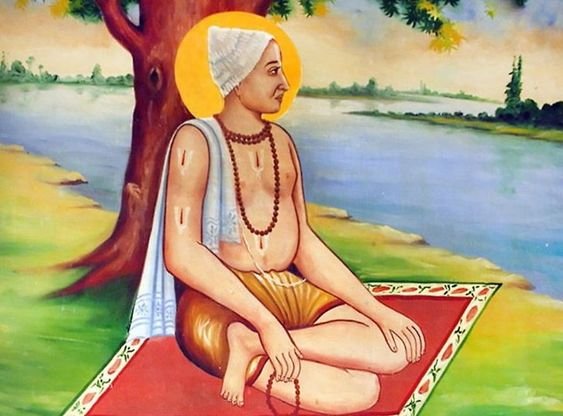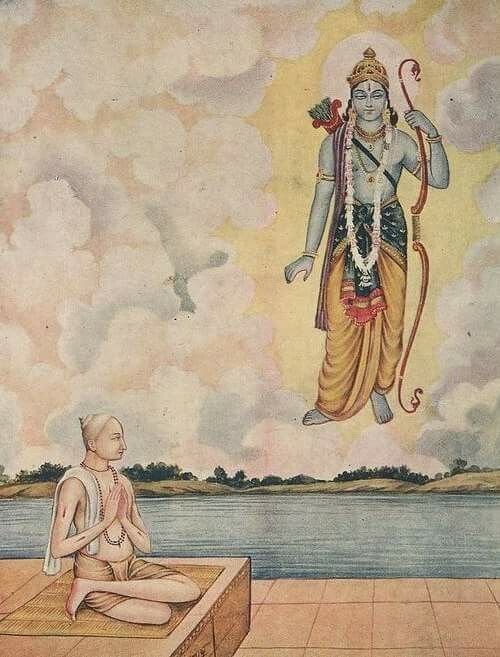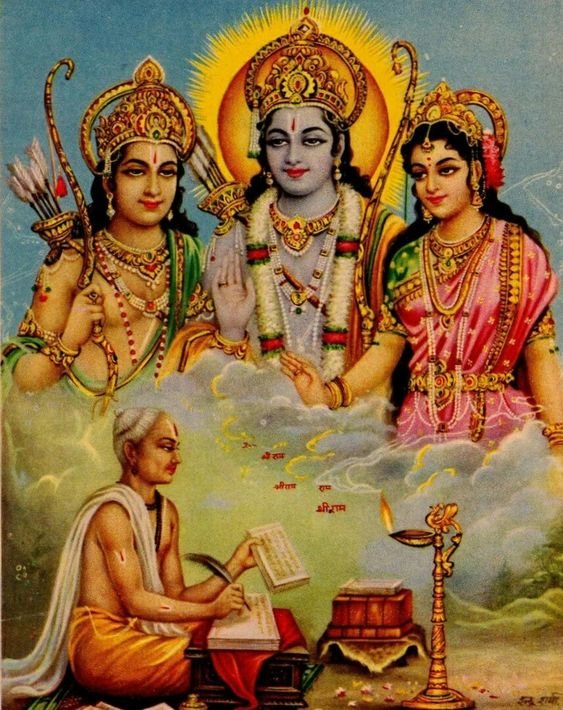Goswami Tulsidas: The Devotional Poet and Saint

Tulsidas, also known as Rambola Dubey, was a revered Hindu saint, poet, and philosopher. His unwavering devotion to Lord Rama led him to compose significant literary works that continue to inspire millions. Among his notable creations are the Hanuman Chalisa and the epic Ramcharitmanas, a retelling of the ancient Sanskrit Ramayana in the vernacular Awadhi language.

Tulsidas was born on August 11, 1511, in Soron (present-day Uttar Pradesh, India). His parents, Aatmaram Dubey and Hulsi Devi, raised him in a devout household. Throughout his life, Tulsidas remained deeply connected to the cities of Banaras (Varanasi) and Ayodhya. Tulsidas’s magnum opus, the Ramcharitmanas, stands as a monumental work. This epic narrates Lord Rama’s life, emphasising devotion, righteousness, and the triumph of good over evil. Written in Awadhi, it resonates with people across generations. The Hanuman Chalisa, a devotional hymn dedicated to Lord Hanuman, showcases Tulsidas’s poetic brilliance. Its 40 verses extol Hanuman’s virtues, courage, and unwavering loyalty to Lord Rama. Millions recite it daily, seeking strength and protection.
Tulsidas founded the Sankat Mochan Hanuman Temple in Varanasi. Legend has it that he had a divine vision of Lord Hanuman at this very spot. The temple remains a sacred pilgrimage site for devotees seeking solace and blessings.Tulsidas pioneered the tradition of Ramlila plays, folk-theatre adaptations of the Ramayana. These vibrant performances celebrate Rama’s valour, Sita’s devotion, and Hanuman’s unwavering service.

Tulsidas’s impact extends far beyond his lifetime:
Literature: His works continue to inspire poets, scholars, and artists. His mastery of Sanskrit, Awadhi, and Braj Bhasha enriched Indian literature.
Culture: Ramlila plays Hindustani classical music, and popular songs draw from Tulsidas’s legacy.
Spirituality: His devotion to Lord Rama exemplifies unwavering faith and bhakti.
Tulsi Ghat: The Tulsi Ghat on the Ganges in Varanasi immortalises his name.
Tulsidas’s influence reverberates through time, touching hearts and minds across India and beyond. His devotion, wisdom, and literary contributions make him a beacon of spiritual light in our cultural tapestry.

His impact through time and is felt in various aspects:
Tulsidas’s use of Awadhi in his writings helped popularise the language and made it accessible to a wider audience. His poetry, known for its simplicity and accessibility, transcends social boundaries, touching people from all walks of life.
Ramcharitmanas: His magnum opus, the Ramcharitmanas, retells the ancient Sanskrit
Tulsidas, the revered Vaishnava Hindu saint and poet, left an indelible mark on Indian literature, culture, and society. His impact through time and is felt in various aspects:
Tulsidas’s use of Awadhi in his writings helped popularise the language and made it accessible to a wider audience. His poetry, known for its simplicity and accessibility, transcends social boundaries, touching people from all walks of life.
Hanuman Chalisa: Tulsidas’s devotional hymn dedicated to Lord Hanuman continues to inspire millions. Its verses extol Hanuman’s virtues and unwavering loyalty to Lord Rama. Sankat Mochan Hanuman Temple: Founded by Tulsidas in Varanasi, this temple stands at the spot where he had a divine vision of Lord Hanuman.
Ramlila Plays: Tulsidas pioneered the tradition of Ramlila plays, folk-theatre adaptations of the Ramayana, celebrating Rama’s valour and Sita’s devotion. Tulsidas is acclaimed as one of the greatest poets in Hindi, Indian, and world literature.
Culture: Ramlila plays, Hindustani classical music, popular music, and television series draw from his legacy.
Spirituality: His devotion to Lord Rama exemplifies unwavering faith and bhakti.
Tulsi Ghat: The Tulsi Ghat in Varanasi immortalises his name.

The core of the Hanuman Chalisa. Each Chaupai is a four-line verse, meticulously crafted to extol various attributes and deeds of Lord Hanuman. These verses celebrate his strength, devotion, courage, and unwavering loyalty to Lord Rama. Devotees recite these Chaupais seeking Hanuman’s blessings, protection, and strength. After the 40 Chaupais, the Chalisa concludes with another Doha. This final couplet serves as a closing prayer, expressing gratitude and reverence to Hanuman.
The Ramcharitmanas consists of seven Kānds or sections, each representing a significant phase of Lord Rama’s life.
These Kānds are akin to seven steps leading into the holy waters of Lake Manasarovar, symbolising purification of both body and soul. Each Kānd unfolds a specific aspect of Lord Rama’s journey, from his birth to becoming the King of Ayodhya. The entire Ramcharitmanas is composed of approximately 12,800 lines. These lines are further divided into 1,073 stanzas (verses), meticulously crafted by Tulsidas Tulsidas, a great scholar of Sanskrit, who deliberately chose to write the Ramcharitmanas in the vernacular Awadhi language.

By doing so, he made this sacred text accessible to the common people, bridging the gap between scholarly knowledge and popular devotion.
Tulsidas’s spiritual practices and beliefs:
Tulsidas followed the Vishishtadvaita philosophy, emphasising the oneness of all beings with the divine. His compositions, including the iconic Ramcharitmanas, exude profound love and devotion towards Lord Rama and his consort, Sita. Through his poetry, Tulsidas conveyed the transformative power of unwavering love and devotion to God. It is said that Tulsidas had a vision of Lord Rama, who instructed him to write an epic poem narrating the life and exploits of the divine hero. Inspired by this divine directive, Tulsidas penned the magnum opus, the Ramcharitmanas, retelling the Ramayana in Awadhi, a dialect of Hindi. Tulsidas immersed himself in bhakti (devotion) through regular recitation of sacred texts, meditation, and chanting. His unwavering faith in Lord Rama fueled his creative expression and literary endeavours. Tulsidas’s life exemplified the path of devotion, service, and surrender to the divine. Tulsidas’s literary prowess and spiritual depth earned him acclaim as one of the greatest poets not only in Hindi literature but also in Indian and world literature. His enduring legacy extends beyond literature, permeating various aspects of Indian society, including art, music, and religious practices. The Tulsi Ghat on the banks of the Ganges in Varanasi stands as a testament to his revered status, immortalising his contribution to Indian culture and spirituality.

Tulsidas shared a profound spiritual connection with Lord Rama. His interactions with the divine hero shaped his life, writings, and legacy:
It is said that Tulsidas had a vision of Lord Rama himself. In this divine encounter, Lord Rama instructed Tulsidas to write an epic poem narrating His life and exploits. Inspired by this celestial directive, Tulsidas penned the magnum opus, the “Ramcharitmanas”, a retelling of the ancient Sanskrit Ramayana in the vernacular Awadhi language. Tulsidas’s unwavering devotion to Lord Rama permeates every verse of the Ramcharitmanas. Through beautiful poetry, storytelling, and philosophical insights, he reimagined the divine story, adding his unique touch of devotion and spirituality. His compositions resonate with profound love for Rama and his consort, Sita. In his work “Vinaya Patrika”, Tulsidas implored Lord Rama for devotion and guidance. The final stanza of the Vinaypatrika attests to Tulsidas’s deep connection with the divine. He claimed that Rama himself signed the manuscript, validating his supplication. Tulsidas’s literary prowess and spiritual depth earned him acclaim as one of the greatest poets not only in Hindi literature but also in Indian and world literature. His enduring legacy extends beyond literature, touching various aspects of Indian society, including art, music, and religious practices. The Tulsi Ghat on the banks of the Ganges in Varanasi stands as a testament to his revered status, immortalising his contribution to Indian culture and spirituality.

Tulsidas’s life was a harmonious blend of devotion, creativity, and unwavering faith. His divine vision of Lord Rama propelled him to create literary masterpieces like the Ramcharitmanas and the Hanuman Chalisa. Through his works, he not only enriched Indian literature but also left an indelible spiritual legacy. Tulsidas’s devotion continues to inspire millions, bridging the gap between the earthly and the divine, and reminding us of the transformative power of love and faith .


